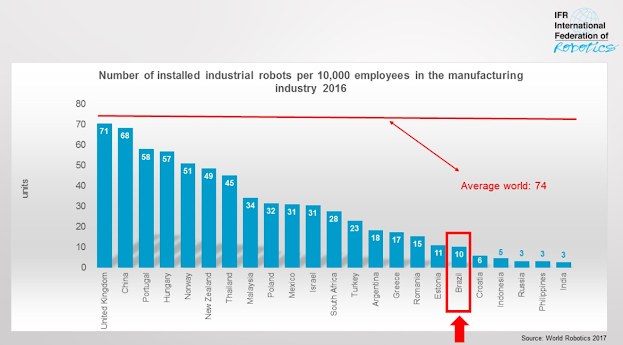(English version at the bottom)
Tive o prazer de bater um papo com Edmilson Abreu e Leandro Carvalho
Edmilson e Leandro possuem sólida bagagem trabalhando em projetos de integração de sistemas automatizados e perceberam algumas lacunas no país nesse campo. Podemos ilustrar uma dessas lacunas observando os gráficos abaixo realizados pela International Federation of Robotics (IFR). Esse benchmarking é usado com frequência para análises e comparações do avanço industrial entre países. Observa-se, com base no número de robôs para cada dez mil empregados em manufatura, que o Brasil está aproximadamente sete vezes inferior à China e à média mundial. Além disso, a Brasil está longe dos países no topo da lista como a Coreia do Sul, Singapura e Alemanha.
De fato, com um câmbio desvalorizado, burocracia excessiva e altos impostos, é muito difícil ganhar competitividade industrial ao nível mundial, pois grande parte dos dispositivos industriais tais como Controladores Lógico Programáveis (CLP) e robôs são importados. No entanto, os entrevistados pensaram em uma maneira de contornar essas dificuldades de modo a permitir aos industriais haver investimentos iniciais menores, por meio de plataformas de Robot as a Service (RaaS). Alguns exemplos de serviços desse tipo são os aluguéis de sistemas Automated Guided Vehicles (AGVs) e de robótica colaborativa.
Outro serviço oferecido pela dupla é a integração de sistemas SCADA, usando o produto Ignition da Inductive Automation. O Ignition é um produto excelente para esse tipo de aplicação por diversos motivos técnicos e financeiros. Além disso, os entrevistados possuem anos de experiência, certificações e treinamentos que os tornam capazes de entregar projetos ao nível de estado da arte para manufatura avançada. Um dos diferenciais oferecidos é a possibilidade de haver uma digitalização completa da fábrica, desde às máquinas e linhas de produção, até mesmo os sistemas de utilidades e de segurança contra incêndio.
Uma métrica usada na indústria para estimar o tamanho de um projeto SCADA, é o número total de tags. As tags são normalmente coletadas dos Controladores Lógico Programáveis (CLP) por meio de uma comunicação OPC-UA, entre o servidor do projeto SCADA e os CLPs do chão da fábrica. Elas representam, entre outros, sinais de entrada e saída analógicas e digitais conectados ao CLP. Um dos projetos realizado pelos entrevistados possui entre vinte e vinte e cinco mil tags. Este projeto de grande porte projeto possui também um sistema de alarmes e notificações por SMS e e-mail, além do tradicional alarme mostrado nas telas usadas pelos operadores.
A COVID-19 sem dúvidas afetou negativamente empresas de diversos setores. Porém, observando de outra perspectiva, a pandemia obrigou uma aceleração na transformação digital. Em poucas semanas, por exemplo, as empresas tiveram que se re-organizar, planificar um acesso remoto ao chão da fábrica, melhorar a infra-estrutura de seus servidores devido a uma maior demanda. Soluções como as oferecidas pelo Edmilson e Leandro se inserem perfeitamente nesse cenário e podem permitir um avanço significativo da competitividade da empresa.
-----
I had the pleasure of having a chat with Edmilson Abreu and Leandro Carvalho who develop industry 4.0 solutions. Our conversation covered the current automation scenario that many companies are going through, and, in particular, one of the services offered by them for the execution of large SCADA and MES projects.
Edmilson and Leandro have a solid background working in projects of automated systems integration and have noticed some gaps in Brazil in this field. We can illustrate one of these gaps by looking at the graphs below made by the International Federation of Robotics (IFR). This benchmarking is often used for analysis and comparison of industrial advancement between countries. It can be seen, based on the number of robots for every ten thousand employees in manufacturing, that Brazil is approximately seven times below China and the world average. Furthermore, Brazil is far behind countries at the top of the list such as South Korea, Singapore, and Germany.
In fact, with a devalued exchange rate, excessive bureaucracy and high taxes, it is very difficult to gain industrial competitiveness at a global level, since most industrial devices such as Programmable Logic Controllers (PLC) and robots are imported. However, the interviewees thought of a way around these difficulties in order to allow industrialists to have smaller initial investments, through Robot as a Service (RaaS) platforms. Some examples of such services are rentals of Automated Guided Vehicles (AGVs) and collaborative robotics systems.
Another service offered by the duo is the integration of SCADA systems, using Inductive Automation's Ignition product. Ignition is an excellent product for this type of application for several technical and financial reasons. In addition, the interviewees have years of experience, certifications, and training that make them capable of delivering state-of-the-art projects for advanced manufacturing. One of the differentials offered is the possibility of having a complete digitalization of the factory, from the machines and production lines, to the utilities and fire safety systems.
One metric used in the industry to estimate the size of a SCADA project, is the total number of tags. Tags are typically collected from the Programmable Logic Controllers (PLC) via an OPC-UA communication between the SCADA project server and the PLCs on the plant floor. They represent, among others, analog and digital input and output signals connected to the PLC. One of the projects carried out by the interviewees has between twenty and twenty-five thousand tags. This large project also has an alarm system and notifications via SMS and e-mail, besides the traditional alarm shown on the screens used by the operators.
COVID-19 undoubtedly negatively affected companies in a variety of industries. But looking at it from another perspective, the pandemic forced an acceleration in digital transformation. In just a few weeks, for example, companies had to re-organize, plan remote access to the shop floor, improve their server infrastructure due to increased demand. Solutions like the ones offered by Edmilson and Leandro fit perfectly in this scenario and can allow a significant advance in the company's competitiveness.




No comments:
Post a Comment